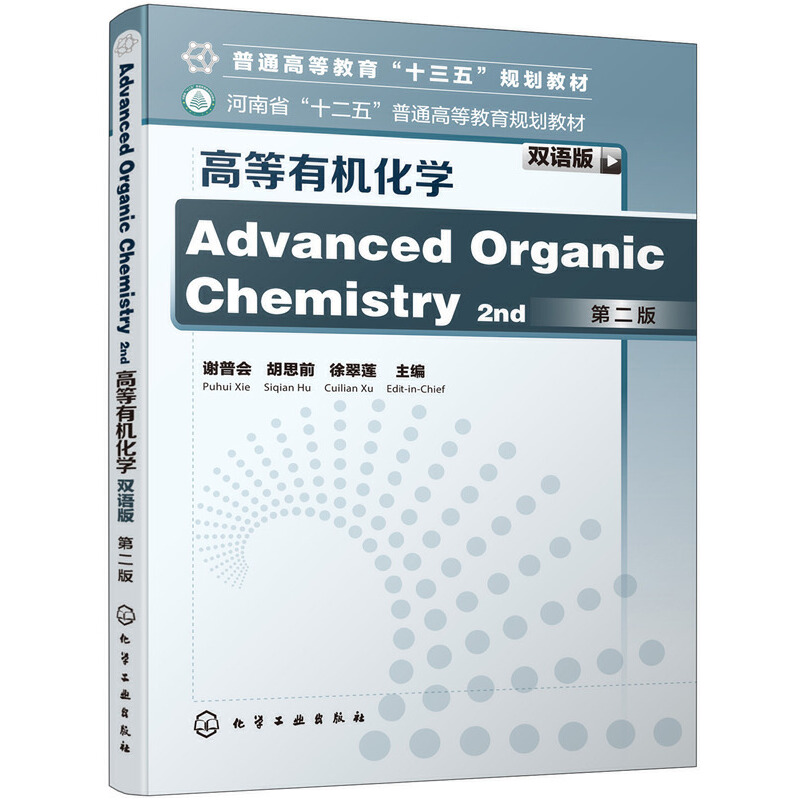
Advanced Organic Chemistry高等有机化学(双语版)(第二版)

- ISBN:9787122355553
- 装帧:平装-胶订
- 册数:暂无
- 重量:暂无
- 开本:16开
- 页数:228页
- 出版时间:2020-02-01
- 条形码:9787122355553 ; 978-7-122-35555-3
本书特色
《高等有机化学(双语版)第二版(Advanced Organic Chemistry 2nd)》第1 章介绍了分子结构和化学键与反应活性的定性关系。第2 章为立体化学,主要介绍了立体异构、消旋化合物的拆分、立体选择性和立体特异性反应、不对称合成等。第3 章主要介绍有机反应的类型,通过举例来解释反应机理,并结合机理讨论反应中间体的结构、稳定性和化学性质。第4 章讨论亲核取代反应的机理、立体化学和影响因素。第5 章讨论加成和消除反应的机理和立体化学。第6 章主要介绍羰基化合物的亲核加成反应。第7 章介绍重排反应。第8 章讨论芳香亲核和亲电取代反应,同时介绍定位效应。第9 章介绍各类氧化和还原反应及歧化反应。第10 章介绍周环反应。每章后附有相关习题、专业术语词汇表。为方便学生理解,每章后有中文列出的知识要点。《高等有机化学(双语版)第二版(Advanced Organic Chemistry 2nd)》可供化学类专业高年级本科生和研究生使用,亦可供从事高等有机化学教学的教师参考。
内容简介
《高等有机化学(双语版)第二版(Advanced Organic Chemistry 2nd)》第1章介绍了分子结构和化学键与反应活性的定性关系。第2章为立体化学,主要介绍了立体异构、消旋化合物的拆分、立体选择性和立体特异性反应、不对称等。第3章主要介绍有机反应的类型,通过举例来解释反应机理,并结合机理讨论反应中间体的结构、稳定性和化学性质。第4章讨论亲核取代反应的机理、立体化学和影响因素。第5章讨论加成和消除反应的机理和立体化学。第6章主要介绍羰基化合物的亲核加成反应。第7章介绍重排反应。第8章讨论芳香亲核和亲电取代反应,同时介绍定位效应。第9章介绍各类氧化和还原反应及歧化反应。第10章介绍周环反应。每章后附有相关习题、术语词汇表。为方便学生理解,每章后有中文列出的知识要点。 《高等有机化学(双语版)第二版(Advanced Organic Chemistry 2nd)》可供化学类高年级本科生和研究生使用,亦可供从事高等有机化学教学的教师参考。
目录
1.1 Localized chemical bonding(定域化学键) 1
1.2 Dipole moments(偶极矩) 3
1.3 Inductive effects and field effects(诱导效应和场效应) 4
1.4 Delocalized chemical bonding(离域共价键) 6
1.5 Resonance structures(共振结构) 8
1.6 Conjugative effect(共轭效应) 9
1.7 Hyperconjugative effect(超共轭效应) 11
1.8 Steric effect(立体效应) 12
1.9 Aromaticity and Hückel’s rule(芳香性与休克尔规则) 14
Problems 23
Vocabulary 25
Chapter 2 Stereochemistry(立体化学) 26
2.1 Enantiomers(对映异构体) 27
2.2 Resolution of racemates(外消旋体的拆分) 37
2.3 The stereochemistry in reaction process(反应过程中的立体化学) 40
Problems 49
Vocabulary 50
Chapter 3 Mechanisms of Organic Reactions(有机反应机理) 51
3.1 Types of reaction mechanisms(反应机理的类型) 51
3.2 The properties and characteristics of organic reactions(有机反应的性质和特点) 56
3.3 How do organic reactions occur: mechanisms(有机反应如何发生:机理) 59
3.4 Describing a reaction: intermediates(反应的描述:中间体) 62
3.5 Methods of determining mechanisms(确定反应机理的方法) 68
Problems 70
Vocabulary 72
Chapter 4 Nucleophilic Substitution(亲核取代反应) 73
4.1 Mechanisms of nucleophilic substitutions(亲核取代反应的机理) 74
4.2 Stereochemistry of nucleophilic substitutions(亲核取代反应的立体化学) 76
4.3 Nucleophiles and nucleophilicity(亲核试剂和亲核性) 77
4.4 The factors that can influence the rates of SN1, SN2 reactions(影响单分子、双分子亲核取代反应速率的因素) 79
4.5 Neighboring-group participation effect(邻基参与效应) 83
Problems 87
Vocabulary 88
Chapter 5 Addition and Elimination Reactions(加成与消除反应) 90
5.1 Electrophilic addition reactions(亲电加成反应) 90
5.2 Elimination reactions(消除反应) 95
5.3 Competition between elimination and substitution(消除反应与取代反应的竞争) 102
Problems 103
Vocabulary 105
Chapter 6 Reactions of Carbonyl Compounds(羰基化合物的反应) 106
6.1 The nucleophilic addition reaction mechanisms(亲核加成反应机理) 106
6.2 The nucleophilic addition reactions to the carbonyl groups(羰基的亲核加成反应) 107
6.3 The addition and elimination reactions(加成与消除反应) 111
6.4 The reactivity and stereoselectivity of nucleophilic additions(亲核加成反应的活性和立体选择性) 112
6.5 Condensation reactions(缩合反应) 114
6.6 Reaction with ylides(与叶立德的反应) 121
6.7 The nucleophilic substitutions of carboxylic acids and their derivatives(羧酸及其衍生物的亲核取代反应) 122
Problems 125
Vocabulary 127
Chapter 7 Rearrangements(重排) 128
7.1 Nucleophilic rearrangements(亲核重排) 128
7.2 Electrophilic rearrangements(亲电重排) 140
7.3 Rearrangements on aromatic rings(芳环重排) 144
Problems 147
Vocabulary 148
Chapter 8 Electrophilic and Nucleophilic Aromatic Substitutions(芳香亲电取代与亲核取代) 150
8.1 Electrophilic aromatic substitution(芳香亲电取代) 150
8.2 Specific electrophilic aromatic substitution reactions(特殊的芳香亲电取代反应) 151
8.3 Directing effects of substituents(取代基的定位效应) 158
8.4 Effects of multiple substituents on electrophilic aromatic substitution(多取代基对芳香亲电取代反应的影响) 160
8.5 Nucleophilic aromatic substitution(芳香亲核取代反应) 160
Problems 164
Vocabulary 166
Chapter 9 Oxidation and Reduction Reactions(氧化还原反应) 167
9.1 Oxidation of alkenes and alkynes(烯烃和炔烃的氧化) 167
9.2 Oxidation of alcohols(醇的氧化) 170
9.3 Oxidation of aldehydes and ketones(醛和酮的氧化) 174
9.4 Oxidation of aromatic side chains and the aromatic rings(芳香侧链和芳环的氧化) 176
9.5 Reduction reactions(还原反应) 176
9.6 Other reduction reactions(其它还原反应) 186
9.7 Disproportionation reactions(歧化反应) 189
Problems 190
Vocabulary 192
Chapter 10 Pericyclic Reactions(周环反应) 193
10.1 Electrocyclic ring opening/closure reactions(电环化开环/关环反应) 194
10.2 Cycloaddition reactions(环加成反应) 198
10.3 Sigmatropic rearrangements(σ重排反应) 205
Problems 209
Vocabulary 210
Appendix Ⅰ 《Advanced Organic Chemistry》Final Test(1) 212
Appendix Ⅱ 《Advanced Organic Chemistry》Final Test(2) 217
Appendix Ⅲ 《Advanced Organic Chemistry》Final Test(3) 223
参考文献 228
作者简介
谢普会,河南农业大学,教授,自2007年起在河南农业大学理学院任教,主要承担课程:高等有机化学、有机化学、专业英语、基础化学实验等课程,其中高等有机化学与2011年获河南省高校双语教学示范课程。自2000年起一直从事科研工作,已发表科研论文50余篇。
-

当代中国政府与政治(新编21世纪公共管理系列教材)
¥33.6¥48.0 -

落洼物语
¥8.7¥28.0 -

中国当代文学名篇选读
¥19.1¥53.0 -

中医基础理论
¥50.7¥59.0 -

北大人文课(平装)
¥13.9¥45.0 -

外国教育史-第2版
¥24.4¥40.0 -

宪法-第二版
¥12.2¥29.0 -

当代中国政府与政治 第二版
¥57.8¥68.0 -

EPLAN电气设计
¥29.9¥39.8 -

闯进数学世界――探秘历史名题
¥21.3¥32.8 -

企业法务教程
¥34.8¥49.0 -

习近平新时代中国特色社会主义思想概论
¥18.2¥26.0 -

金融学
¥29.9¥49.0 -

计算机操作系统教程(第4版)(清华大学计算机系列教材)
¥31.9¥49.0 -

三国史
¥27.5¥50.0 -

飞机总体设计
¥46.8¥78.0 -

古代汉语(第四册)
¥16.1¥35.0 -

编辑审稿实务教程
¥35.1¥45.0 -

管理学:原理与方法(第7版)(博学.大学管理类)/周三多
¥30.9¥49.0 -

(平装)北大必修课:北大口才课
¥12.2¥45.0











